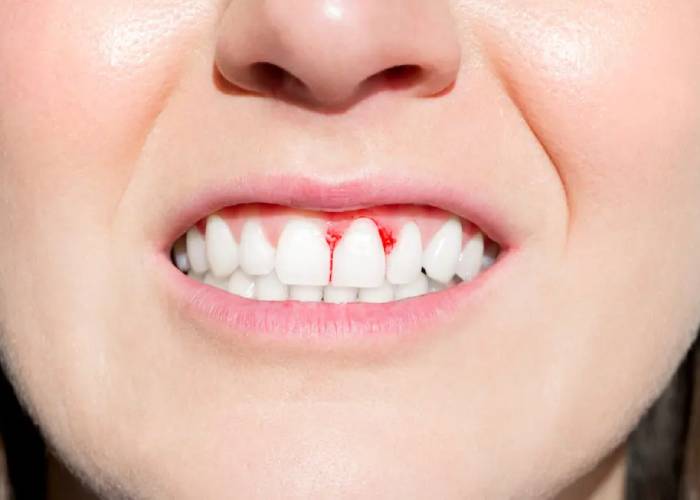Bleeding Gums? Learn About Gum Disease and the Risk

Bleeding gums is one of the signs of gum disease, a common oral health issue that affects nearly half of all adults. Also called periodontal disease, when left untreated, can worsen and affect the supporting bone beneath the gum-line. Indeed, gum disease is the leading cause of tooth loss.
What Causes Gum Disease?
A build-up of plaque on the teeth is the primary cause. Without good oral care practices, bacteria within plaque can cause an infection in the gums. The longer the plaque is allowed to build up the more potential for periodontal disease.
However, genetics can also play a part. If there is a family history of this oral health issue, then you could also be more likely to have the type of bacteria that causes the condition.
What Are the Symptoms?
When your gums are healthy, they are nice and firm. Periodontal disease has several symptoms, and these can develop as the condition worsens. The symptoms include:
- bleeding gums
- swollen gums
- red or purple coloring to the gums
- bad breath
- bad taste in the mouth
- gums starting to pull away from the teeth
- pain when you chew
- loose teeth
You should not wait for any pain or discomfort before seeking professional help. Many people will not experience pain, particularly in the early stages, when it is known as gingivitis. Once your gums swell or begin to bleed, you should consult with your doctor, as gum disease is treatable in the early stages.
Risk Factors
Since a primary cause is a build-up of plaque, poor oral care is a major contributing risk factor for the condition. If you lapse in how often you brush your teeth, floss, and visit your dentist for regular check-ups, you place yourself at an increased risk of a build-up of bacterial plaque that can cause infection.
As discussed, genetics is also a risk factor if you have a family history of the disease. Other health conditions are linked to this oral health issue too, including heart disease, diabetes and autoimmune diseases such as lupus and Crohn’s disease.
Lifestyle choices like smoking will also increase your risk. Smoking impacts the body’s immune system, making it harder for the body to counter any infection within the gums due to plaque. Smoking can also make it harder for the gums to heal.
Stress is another risk factor as it can also weaken your immune system’s ability to ward off infection.
Ways To Reduce Your Risk Of Gum Disease
Gum disease can be prevented for the most part since one of the leading causes is poor oral hygiene. Ways to reduce your risk include:
- brushing your teeth at least twice daily
- flossing daily
- rinsing your mouth with an antibacterial mouthwash
- regular appointments with your dentist
- quitting smoking
How often you visit your dentist for a regular check-up can vary from person to person. Your dentist will advise you how often you should see them. In the case of someone genetically disposed to periodontal disease, their dentist will likely recommend more regular visits to help remove accumulated plaque more often.
How Periodontal Disease Progresses
Periodontal disease can be a slow-burner, the infection gradually damaging the gum tissue before affecting the supporting bone. There are four main stages of the disease.
1. Gingivitis
This is the early stage of the disease and is treatable. Your gums may swell and redden in color. When you brush your teeth, they may also bleed. Although you are unlikely to have any pain, the symptoms should not be ignored as this is the stage when the condition can be treated and reversed rather than just managed.
2. Mild stage
Your gums start to recede from the teeth as the bacteria has now reached beneath the gum line. The pockets formed by this recession of the gums can play host to more bacteria.
3. Moderate stage
The bacteria start to impact the supporting bone. The ligaments and tissue around the bone are worn down and you may start to experience pain. Bad breath is another symptom at this stage.
4. Advanced stage
Left untreated, you continue to lose more bone density. At this advanced stage of periodontitis you can experience tooth loss. Once you reach this point of bone loss the condition can not be reversed, only managed.
Treatment Options
Your dentist will assess for gum disease, and if present, the severity of the condition. Early intervention makes treating the condition simpler and reversible. However, once you lose the structures supporting the teeth, it is about management rather than cure.
The following are four possible treatments for the various stages of periodontal disease.
Improved oral care regime – while still at the early stages of gingivitis, improving your oral care regime, including twice daily brushing, daily flossing and regular dental appointments, can be enough to remove the plaque and bacteria before it has the chance to progress further.
Scaling and root planing – this is a deeper clean often performed by a dental hygienist. It removes plaque from areas where a toothbrush may not reach and is a good solution for mild periodontitis.
Pocket reduction surgery – used in cases of moderate to advanced periodontal disease to remove plaque that has penetrated well beneath the gums.
Grafts – bone or gum tissue grafts can be used to replace bone or tissue lost to the disease
Further treatments such as one using a laser that targets the diseased gum tissue may also be discussed with your dentist. However, the treatment recommended will depend on the severity and progress of the disease.
If you experience bleeding gums when brushing your teeth, it could be a sign of early gum disease. Consult with your dentist as soon as you are able, as the condition can be reversed at an early stage.




